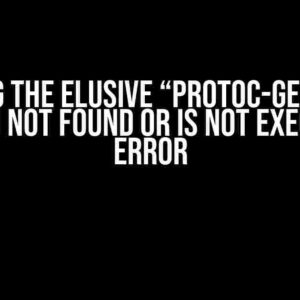Are you frustrated because pip install seems to be working just fine, but when you try to run your code, you’re met with a slew of errors? Don’t worry, you’re not alone! This article will walk you through a series of troubleshooting steps to help you identify and resolve the issue. So, buckle up and let’s dive in!
Step 1: Check Your Python Version
Before we begin, ensure you’re running the correct version of Python. You can check your Python version by opening a terminal or command prompt and typing:
python --versionIf you’re running an outdated version, consider upgrading to the latest version. Now, let’s move on to the next step.
Step 2: Verify Package Installation
Next, verify that the package you installed using pip is indeed installed correctly. You can do this by running:
pip list <package_name>Replace <package_name> with the actual name of the package you’re trying to install. If the package is installed correctly, you should see it listed in the output.
Common Issues with Package Installation
Sometimes, package installation can fail due to various reasons. Here are a few common issues and their solutions:
- Permission Issues: Try running pip with administrator privileges by using
sudo pip install <package_name>(on Linux/Mac) orpip install <package_name>as an administrator (on Windows). - Network Connectivity Issues: Check your internet connection and try installing the package again. You can also try using a mirror or a different package repository.
- Package Conflicts: If you’re installing a package that has conflicting dependencies, try using
pip install --user <package_name>to install the package in the user directory instead of the system directory.
Step 3: Check Your Code
Now that we’ve verified package installation, let’s take a closer look at your code. Here are a few things to check:
Syntax Errors
Syntax errors can cause your code to fail miserably. Check for any typos, missing brackets, or incorrect indentation. You can use tools like PEP8 or PyLint to help you identify syntax errors.
Import Errors
Ensure you’re importing the package correctly. For example, if you installed a package called “my_package”, you should import it using:
import my_packageor
from my_package import module_nameVersion Conflicts
If you’re using multiple versions of a package, it can cause conflicts. Ensure you’re using the correct version of the package by specifying the version number while importing:
import my_package==1.2.3Step 4: Check Your Environment
Next, let’s take a look at your environment:
Virtual Environments
If you’re using a virtual environment, ensure it’s activated before installing packages. You can check if you’re in a virtual environment by running:
which pythonIf you’re not in a virtual environment, consider creating one using tools like conda or virtualenv.
System Configuration
System configuration issues can also cause problems. Check your system’s PATH variable to ensure Python and pip are correctly configured. You can do this by running:
echo $PATHOn Windows, you can check the system environment variables by going to System Properties > Advanced > Environment Variables.
Step 5: Debug Your Code
If you've checked everything and still getting errors, it's time to debug your code. Here are a few techniques to help you identify the issue:
Print Statements
Add print statements throughout your code to identify the point where the error occurs. This can help you narrow down the issue.
print("I'm here!")PDB Debugger
Use the built-in PDB debugger to step through your code and identify the error. You can do this by running:
python -m pdb your_script.pyOnce you're in the debugger, you can use commands like n to step through the code and p to print variables.
Common Error Messages
Here are a few common error messages you might encounter and their solutions:
| Error Message | Solution |
|---|---|
ModuleNotFoundError: No module named '<package_name>' |
Ensure the package is installed correctly and you're importing it correctly. |
ImportError: cannot import name '<module_name>' from '<package_name>' |
Check if the module is part of the package and if you're importing it correctly. |
AttributeError: module '<package_name>' has no attribute '<function_name>' |
Ensure the function or attribute exists in the package and you're calling it correctly. |
Conclusion
pip install seems to be working, but when you try to run code, you get thrown an error – it's a frustrating problem, but with these troubleshooting steps, you should be able to identify and resolve the issue. Remember to check your Python version, verify package installation, inspect your code, examine your environment, and debug your code. Happy coding!
Still stuck? Feel free to ask for help in the comments below!
Here is the HTML code for 5 Questions and Answers about "pip install seems to be working, but when I try to run code I get thrown an error":
Frequently Asked Questions
Are you stuck with a puzzling error that's driving you crazy? Don't worry, we've got you covered!
I ran pip install successfully, but why can't I import the module in my Python script?
This might be due to multiple Python versions installed on your system. Make sure you're running the correct Python version where you installed the module. Try running `python --version` and `pip --version` to check which version you're using. If you have multiple versions, use `pip3` or `pip2` instead of just `pip` to specify the version.
I'm getting a "No module named" error despite installing the module successfully. What's going on?
This could be due to a naming conflict. Check if your Python script has the same name as the module you're trying to import. If so, rename your script to something else. Also, ensure that you're not trying to import a module that's not installed or has a typo in its name.
I've installed the module using pip, but I'm still getting an error when trying to run my code. What should I do?
Try reinstalling the module using `pip uninstall
I'm using a virtual environment, but I still get an error when trying to run my code. What's wrong?
Make sure you've activated your virtual environment before installing the module. You can do this by running `source venv/bin/activate` (on Linux/Mac) or `venv\Scripts\activate` (on Windows). Also, ensure that you're installing the module in the correct virtual environment.
I've tried everything, but I still get an error. What's my next step?
Don't worry, we've all been there! Try debugging your code step by step using a tool like `pdb` or a Python IDE like PyCharm. Also, check online forums and documentation for the specific module you're trying to use. If all else fails, ask for help on platforms like Stack Overflow or GitHub.




